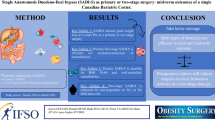Abstract
Background
Laparoscopic sleeve gastrectomy (LSG) is currently gaining ground as a new option for the treatment of morbid obesity. The main advantages of this procedure are less postoperative food restrictions, no vomiting, and absence of late complications due to the lack of foreign implants. The aim of this study is to present our experience with this new bariatric technique.
Methods
Ninety three obese patients (65 females and 28 males) who underwent LSG between September 2005 and September 2007 were studied in terms of postoperative complications and weight loss.
Results
Mean age was 38.37 ± 10.81 years (range 19–69) and mean preoperative weight and body mass index (BMI) were 139.12 ± 24.03 kg (range 100–210) and 46.86 ± 6.48 kg/m2 (range 37–66), respectively. Mean follow-up was 12.51 ± 4.15 months (range 3–24). There were no mortalities, but there were four major and four minor postoperative complications. The mean postoperative excess weight loss (EWL) was 58.32 ± 16.54%, while mean BMI dropped to 32.98 ± 6.54 kg/m2. Mean EWL 3, 6, 12, and 24 months after the operation was 31%, 53%, 67%, and 72%, respectively. Superobese patients (BMI > 50 kg/m2) lost less weight.
Conclusion
In the short term, LSG is a safe and highly effective bariatric operation more suitable for intermediate morbidly obese patients with BMI between 40 and 50 kg/m2.
Similar content being viewed by others
References
Hess DS, Hess DW. Biliopancreatic diversion with duodenal switch. Obes Surg. 1998;8:267–82.
Hess DS, Hess DW, Oakley RS. The biliopancreatic diversion with the duodenal switch: results beyond 10 years. Obes Surg. 2005;15:408–16.
Marceau P, Biron S, Bourque RA, et al. Biliopancreatic diversion with a new type of gastrectomy. Obes Surg. 1993;3:29–35.
Regan JP, Inabnet WB, Gagner M, et al. Early experience with two-stage laparoscopic Roux-en-Y gastric bypass as an alternative in the super-super obese patient. Obes Surg. 2003;13:861–4.
Almogy G, Crookes PF, Anthone GJ. Longitudinal gastrectomy as a treatment for the high-risk superobese patient. Obes Surg. 2004;14:492–7.
Mognol P, Chosidow D, Marmuse J. Laparoscopic sleeve gastrectomy as an initial bariatric operation for high-risk patients: initial results in 10 patients. Obes Surg. 2005;15:1030–3.
Cummings DE. Ghrelin and the short- and long-term regulation of appetite and body weight. Physiol Behav. 2006;89:71–84.
Ariyasu H, Takaya K, Tagami T, et al. Stomach is a major source of circulating ghrelin, and feeding state determines plasma ghrelin-like immunoreactivity levels in humans. J Clin Endocrinol Metab. 2001;86:4753–8.
Langer FB, Reza Hoda MA, Bohdjalian A, et al. Sleeve gastrectomy and gastric banding: effects on plasma ghrelin levels. Obes Surg. 2005;15:1024–9.
Johnston D, Dachtler J, Sue-Ling HM, et al. The Magenstrasse and Mill operation for morbid obesity. Obes Surg. 2003;13:10–6.
Himpens J, Dapri G, Cadière GB. A prospective randomized study between laparoscopic gastric banding and laparoscopic isolated sleeve gastrectomy: results after 1 and 3 years. Obes Surg. 2006;16:1450–6.
Baltasar A, Serra C, Pérez N, et al. Laparoscopic sleeve gastrectomy: a multi-purpose bariatric operation. Obes Surg. 2005;15:1124–8.
Milone L, Strong V, Gagner M. Laparoscopic sleeve gastrectomy is superior to endoscopic intragastric balloon as first stage procedure for super-obese patients. Obes Surg. 2005;15:612–7.
Gagner M, Rogula T. Laparoscopic reoperative sleeve gastrectomy for poor weight loss after biliopancreatic diversion with duodenal switch. Obes Surg. 2003;13:649–54
Moon HS, Kim WW, Oh JH. Results of laparoscopic sleeve gastrectomy at 1 year in morbidly obese Korean patients. Obes Surg. 2005;15:1469–75.
Langer BF, Bohdjalian A, Felb XF, et al. Does gastric dilatation limit the success of sleeve gastrectomy as a sole operation for morbid obesity? Obes Surg. 2006;16:166–71.
Roa EP, Kaidar-Person O, Pinto D, et al. Laparoscopic sleeve gastrectomy as treatment for morbid obesity: technique and short-term outcome. Obes Surg. 2006;16:1323–6.
Silecchia G, Boru C, Pecchia A, et al. Effectiveness of laparoscopic sleeve gastrectomy (First stage of biliopancreatic diversion with duodenal switch) on co-morbidities in super-obese high-risk patients. Obes Surg. 2006;16:1138–44.
Author information
Authors and Affiliations
Corresponding author
Rights and permissions
About this article
Cite this article
Skrekas, G., Lapatsanis, D., Stafyla, V. et al. One Year After Laparoscopic “Tight” Sleeve Gastrectomy: Technique and Outcome. OBES SURG 18, 810–813 (2008). https://doi.org/10.1007/s11695-008-9440-z
Received:
Accepted:
Published:
Issue Date:
DOI: https://doi.org/10.1007/s11695-008-9440-z




